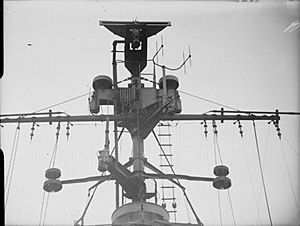Type 293 radar facts for kids

A Type 293 AUR antenna at the upper center aboard HMS Swiftsure at Scapa Flow
|
|
| Country of origin | United Kingdom |
|---|---|
| Introduced | 1945 |
| Type | Aerial-search radar |
| Frequency | 2,997 MHz |
| Beamwidth | 3.2° |
| Range | 20 nmi (37 km; 23 mi) |
| Altitude | 20,000 ft (6,100 m) |
| Power | 500 kW |
The Type 293 radar was a special kind of radar system used on ships, mainly by the British Royal Navy, starting in 1945. It was designed to help ships find aircraft in the sky, especially those flying close by. Think of it like an electronic eye that could see planes even in bad weather or at night.
What is the Type 293 Radar?
The Type 293 radar was created during World War II to give ships a better way to spot enemy aircraft. It was a "short-range aerial-search radar," meaning it could find things in the air that were not too far away. This was important for ships to protect themselves from air attacks.
This radar used a part called a "transmitter" that was similar to another radar system, the Type 277 radar. However, the Type 293 had a brand new "antenna" design. An antenna is the part that sends out and receives the radar signals.
How the Antenna Worked
The antenna for the Type 293 radar was designed to look upwards. Its main job was to scan the sky directly above the ship. This helped give an early warning if any aircraft were approaching.
The antenna was shaped like a "cheese" and was "stabilised." This means it could stay level even when the ship was rocking on the waves. The first version, called AUR, had an antenna that was about 6 feet (1.8 m) across.
Different Versions of Type 293
Over time, the Type 293 radar was improved with different versions. Each new version usually meant a bigger and better antenna.
- Type 293M: This was the first version, put into service in 1945. It used the AUR antenna, which was about 6 feet (1.8 m) wide.
- Type 293P: This version came out in the same year, 1945. It had an upgraded antenna called AQR, which was larger at about 8 feet (2.4 m) across.
- Type 293Q: This was a postwar version, meaning it was developed after World War II ended. It featured an even bigger antenna, the ANS, which measured about 12 feet (3.7 m) across.
All these versions used the same basic power of 500 kilowatts and operated at a frequency of 2,997 MHz. The main difference was the size of the antenna, which helped them see more clearly or further.

